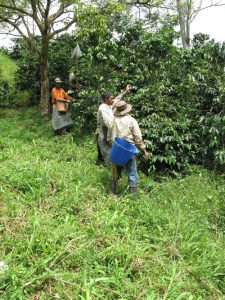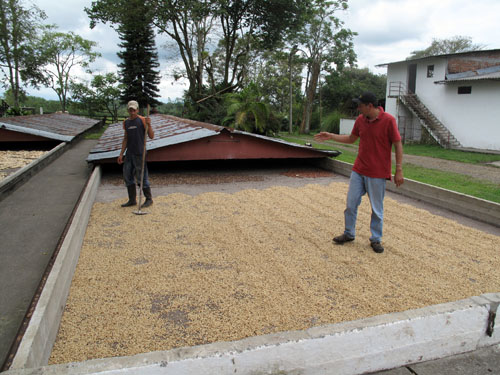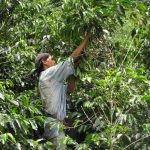Quindío – Coffee Cultivation and Free Trade vs Fair Trade
Coffee cultivation is demanding, with best practices passed along from generation to generation in Colombia. The department of Quindío, the smallest of Colombia, is perfectly situated for coffee growing. With the ideal altitude, soil, climate, and a location close to the equator, the fincas produce the majority of coffee grown in Colombia. And Colombian coffee is prized around the world.

Coffee cultivation is demanding
In the past, there was a loose organization of coffee growers that make the crop profitable. Today, however, coffee prices are set in New York City and the growers receive minimal financial reward for their efforts. Because the fincas have been passed along in the same family for 3 or more generations, the traditional practices are passed along to the next generation. Coffee has been a staple and was a major contributor to the infrastructure and local economies in the past.
But today, the fictional character Juan Valdez appears to be one of the few optimistic coffee cultivators. Unless the family supplements the coffee crop with bananas, fruits, corn, and animal husbandry, not enough money is made to nourish the family. Partly because of this economic situation and partly because of the draw of city life, the younger generation is leaving the small towns and the fincas, leaving aging parents to work the fields as long as they are able and willing.
As long as most growers sell to the international federation at dictated prices, the network of small coffee growers will continue to deteriorate. Free trade is designed to keep crop prices low, ensuring a profit for the National Federation of Coffee Producers, not for the small, local growers. Fair trade is something entirely different, ensuring that the Colombia growers receive a fair price and that their coffee retains some of its quality and individuality.
When you purchase coffee at your supermarket or international espresso bar, you might ask yourself if you are supporting free trade or fair trade. Is your purchase helping the Colombian coffee-growing family or … is it helping a huge corporation that ensures they alone profit? Perhaps it is time to look for independent coffee roasters who import directly from coffee growers, often naming them right on the label. It may cost a bit more, but it is fair trade. Plus, it encourages the younger generation to learn the trade and continue to produce quality coffee because they can earn a living.
Quindío Colombia.

Coffee cultivation is demanding


I think you are being a little hard on free trade here. It is actually doing good, by ensuring that the coffee is sold in the firs place. If coffee where sold at higher prices, a lot less coffee would be sold – which would mean alot of coffee farmers would run out of business.
I think however fairtrade is good, because it gives me the option of buying that coffee that would have been more expensive – and making sure that the farmers also get a part of the revenue.
So free trade makes sure there is a demand for coffee (we would not have a starbucks in every corner if it wasnt for free trade) and fair trade makes sure that people who want to do more good can do it.
I follow this quite much, have a coffeshop myself where we only sell fairtrade coffee, and I run a blog about it http//www.fairtradeship.se – it is in swedish tho. But if you ever travel to sweden feel free to visit – and I will treat you with a good nice cup of fairtrade coffee 🙂
Karsten,
You raise very good points about affordable coffee (Starbucks on every corner) and possibly most costly fair trade coffee. Here in California, perhaps because we are closer to South and Central America, we can purchase fair trade coffee in small supermarkets and in independent coffee shops. For 12 ounces of fair trade coffee (.34 kilos), we pay anywhere from $8.95 to $17.95, with many kinds available at the low end.
Would it be practical for a large number of coffee shops to purchase this way? In some cases here, a collective of 4-5 independent coffee shops have gone together and send a broker to purchase for them, with particular kinds of coffee repeated each year at harvest time.
Truthfully, Starbucks or Folger’s or major grocery store chains could never offer this. On the positive side, though, the growers they buy from are able to offer schools, health care, and other benefits to the growers’ employees. This is just in the early stages, I would estimate.
On the downside, I met a number of growers in Colombia who were letting their coffee plants go untended because they could not afford to break even or even lose a small amount of money. Was this a large group? If I remember correctly, we only spoke with four and were told there were many more.
I am glad that this is a topic that interests you and that you are researching it.
I have not been to Sweden since 1980 when I photographed the world’s hot air balloon race in Uppsala in January.in what was described as the worst winter in 100 years. Very much fun, despite the weather.
Much of what is produced in Brazil, however, is grown on vast coffee farms. For a more intimate Latin American coffee-plantation experience, try Colombia. Here, in the foothills of the Cordillera Central, many of the small-scale local producers have started running coffee finca (farm) tours and stays. Similar to the Italian agriturismo concept, travellers can pay to visit farms in three regions – Quindio, Caldas and Risaralda. Some of the best are listed (in Spanish) on the Quindio tourism website (www.quindio.travel).